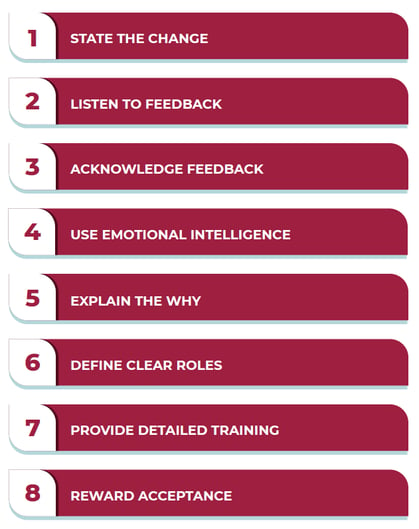When businesses don’t adopt new features and functions, it can often be because there is little-to-no incentive to experiment and implement new technology.
There are times that staff have become too entrenched and set in their ways and are unwilling to adopt new approaches or processes. This is usually because they don’t see the personal benefit of change. This can put a major roadblock in the way for digital transformation and stunt leadership’s ability to drive change.
Changing the culture of a business is one of the most challenging and daunting tasks a leadership team can face. Although difficult, it is necessary to build the right culture, as it is one of the biggest contributors to digital success.
This can mean recognising the current state of the businesses culture, determining what it needs to be for digital transformation to succeed and rallying the business around the new values.

- State the change
It may seem obvious but letting your staff know what changes are being made is an important step to them accepting change. Making them aware early on in the decision making will give them time to come to terms with digital transformation or change initiatives.
- Listen to feedback
Schedule in time to gather feedback from your staff on proposed changes. This could be an online survey, meetings or both. Whatever method you choose, make sure you are recording all feedback.
- Acknowledge the feedback
Another seemingly obvious step, but often we see companies collect feedback from staff but then not do anything with it. It’s important to send out a summary to staff after collecting feedback, addressing concerns and listing any changes that may have arisen from the feedback.
- Use emotional intelligence
It’s important to remember that change can be a daunting time for your employees so use your emotional intelligence skills when engaging with them to help ease their concerns. By empathising with your employees you are going to see more buy-in from them.
- Explain the why
Getting employees on-board with digital transformation and changes in the business is an easier sell when they fully understand why the changes are happening. Explaining to your entire staff why the change is beneficial to the business and themselves will help them to understand and hopefully embrace changes.
- Define clear roles
Make sure everyone knows what their role is and what is expected of them, both through the project and after it is implemented. Confusion around roles can play a large part in employee’s resistance to change.
- Provide detailed training
Whether you have implemented new processes, tools or technologies, it’s important to make sure employees are given detailed training so they can use it effectively. This not only gives them confidence, but also ensures that the new system will be productive and efficient.
- Reward acceptance
Finally, reward employees that accept and embrace the new changes. This can be as simple as giving them praise at the next team meeting or you may set a reward system based on usage. Which ever method you choose, make sure you are rewarding the employees you are on-board with the changes.






Let Us Know What You Thought about this Post.
Put your Comment Below.